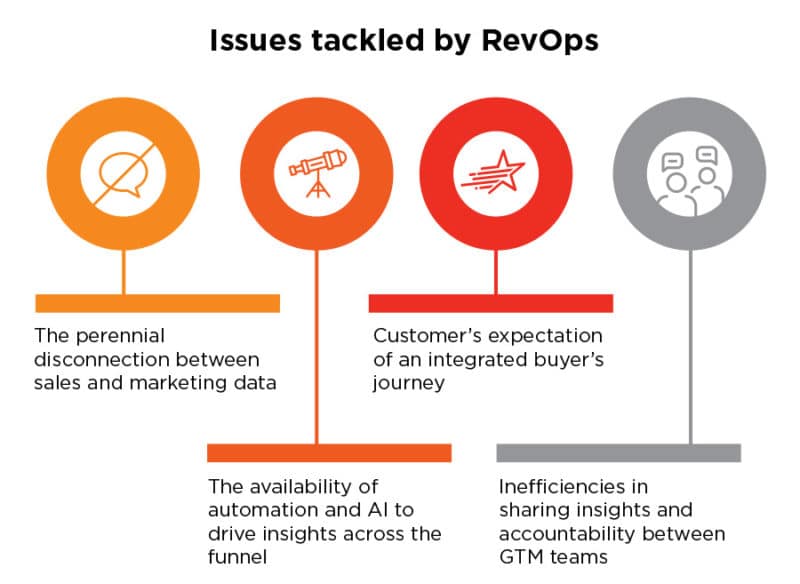
The siloing of marketing and sales has never been good for business, and organizations are starting to agree. That’s given rise to RevOps, short for revenue operations, which is a relatively new organizational structure that seeks to improve alignment between marketing, sales and customer success by bringing separate operation teams together, establishing one reporting line and driving common revenue goals.
The rise of RevOps comes as companies realize that providing a stellar customer experience across all interactions from marketing, sales and service is key to driving revenue. And as customer journeys become more complex and more digital than ever, an alignment model like RevOps can ensure all teams are operating with shared goals and strategies.
But while the high-level promise of organizing these teams in RevOps models is attractive, these are still in the early phase of adoption and are being embraced in different forms by different brands.
This article provides an overview of what RevOps is, why organizations are rapidly embracing the concept, and how you can start taking steps toward implementing RevOps in your organization. We’ll cover:
Estimated reading time: 10 minutes
What is RevOps?
RevOps brings together people, processes, and data from across various departments in an organization, aligning them on three common goals::
- Increasing profits by maximizing customer conversion and profit margin on sales.
- Cutting costs across various departments.
- Finding new opportunities for revenue generation.
With RevOps, you have a dedicated function solely focused on analyzing and overseeing revenue maximization opportunities across the entire organization and customer life cycle.
What’s causing the rise in RevOps?
Traditionally, disconnected sales and marketing teams were the norm and seemed to be working well enough. Each department was expected to work toward meeting its own goals with little to no involvement in the financial and operational planning of another department.
However, this resulted in frequent miscommunication, duplicated efforts, and inconsistencies. Not to mention it only gets messier as you scale up and provide more offerings. There was a clear need for a better, more comprehensive business function that can maximize marketing budgets and user experience without causing big dents in the company’s operational budget.
RevOps is the perfect solution for this because it:
- Helps cut costs and save on the company’s overall expenditure.
- Looks for new opportunities for revenue generation.

How to ensure your RevOps team is successful
Revenue operations, like any other business function, needs to be implemented properly or else it runs the risk of failure. A survey of 270 B2B professionals in the US by RevOps automation vendor Openprise suggests RevOps is falling short and has yet to solve the long-established problem of aligning sales and marketing teams. So, how do you ensure your RevOps strategy is successful?
Let’s start with their fundamental structure. RevOps aims to link marketing, sales, and customer success. Both that doesn’t mean the entirety of those teams is linked into one gargantuan RevOps team. Rather, RevOps teams are compiled by linking key operations talent from within sales and marketing and organizing them into a single operating team.
The success of your RevOps team relies on their ability to act on three important pillars.
Strategy
The RevOps team’s job is to ease processes, find more efficient connections between the siloed departments, and detect pain points. It can do this by strategizing actionable, well-defined plans that are also goal-oriented and effectively communicated throughout the organization.
Keeping your internal and external stakeholders in the loop and ensuring all departments work toward a common goal can help them make better decisions. The RevOps team is also expected to run regular analyses which evaluate market trends and opportunities. These can then be used to shape your business strategies and the actions of different departments. Simply put, supply your RevOps team with tons of market data. It’ll help them make better-informed decisions.
Process
Your RevOps team is also in charge of ensuring that all areas of the organization are running smoothly. A well-defined strategy leads to a smooth business process that ensures maximum efficiency and minimal usage of money and manpower. It’s up to the RevOps team to develop a smooth business process, communicate clearly with all teams involved, and regularly assess each step for effectiveness and potential areas of improvement.
If steps of the process are missed, or stages are out of order, it could ultimately result in inefficiency, delays, added costs, and customer dissatisfaction.
Insights
Insights allow for a consistent feedback loop regarding the above-mentioned strategies and processes. It provides answers to the questions: What are we doing? Is that working for the company? Is there scope for improvement? What other aspects of the strategy and process could be influencing our outcomes?
As mentioned above, industry insights are all about good data. These insights inform your RevOps team of current trends and how (and to what extent) they can be leveraged to help your business. Ultimately, RevOps is about finding and maximizing business opportunities.
Get the daily newsletter digital marketers rely on.
The benefits of RevOps implementation
People, processes, and information working in isolation within an organization can lead to many problems like duplicated efforts, miscommunication, inconsistencies, and inaccurate financial projections. Here’s how RevOps can help solve this:
- Alignment: By bringing together customer-facing departments like sales, marketing, and customer service, businesses can focus on shared goals across departments. It can also ensure that the results of every campaign and customer initiative are measurable from beginning to end.
- Simplification: Employing RevOps simplifies collaboration, removes conflicts and silos amongst departments, and allows for better communication and data to support team members, empowering them to make better decisions and achieve better outcomes. This boosts overall efficiency and creates a better customer experience.
- More accuracy: Forecasting also becomes more accurate, as information is accessible across departments. Having a special RevOps team can make it easier for different teams to collaborate and come up with robust business strategies.
- More strategic use of technology: RevOps can help a company make better use of its technological resources. It can increase conversion, shorten sales cycles, and improve forecast accuracy by using AI and automation to boost accountability across the customer-facing teams.
- Better culture: When you use RevOps to bring teams together and share information, you’re redirecting to transparency and data-driven teamwork. There is a common goal and measurable results that everyone can work toward, preventing conflicts regarding blame or credit.
Ultimately, all of these benefits result in higher success rates and shorter sales cycles, which, in turn, translates to higher revenue and growth.
Frequently asked questions about RevOps
Here are some of the most popular questions marketers ask regarding RevOps.
What is the difference between RevOps and Sales Ops?
Sales operations focus on facilitating sales functions and allowing sales representatives to focus on selling.
On the other hand, revenue operations is about making the entire revenue-generating side of the business more effective at what they do. It works by centralizing four previously disconnected departments, including sales operations, marketing operations, customer success operations, and systems. RevOps is not only about achieving revenue goals but also about providing a positive experience for employees and customers.
What problems does RevOps solve?
Although RevOps focuses on maximizing brand revenue, its benefits go beyond this function. A well-trained RevOps team can resolve a whole host of problems, from improving data quality to building more sustainable work processes.
RevOps builds processes at every stage. RevOps teams help brands unify processes across every department by aligning their functions with campaign goals. Aligning these processes can also help prevent discrepancies in communication, helping craft a consistent and excellent experience for customers.
It addresses inconsistent data and duplicated efforts. RevOps can help marketers identify data issues such as duplicate contacts, inconsistent records, and more. This can help it track the flow of (and any leaks in) revenue throughout the organization.
It breaks down departmental and data silos. RevOps facilitates the breakdown of company silos by tying the revenue success of every department together. It can help resolve disputes between departments by creating a collaborative mindset with a unified goal.
How do you measure the success of RevOps?
RevOps is a collaborative, customer-centric approach to maximizing a business’s revenue potential and minimizing leaks. To measure how well your RevOps team is doing, you should turn toward a constant feedback loop and transparent sharing of information. However, the size of your venture and the length of the project would also play a role in gauging RevOps success.
Ideally, you can track progress by assessing your short-term and long-term revenue goals. You can align short-term goals with your company’s strategies, which can then be divided into actionable parts. The outcome of these actions can be measured, with reference to your goals, through a goal-setting framework.
Long-term goals are slightly more complicated to measure and involve various analyses, such as evaluating your pricing, competition, sales funnel, and churn:
Pricing analysis. Knowing your company’s pricing history can help you understand how customers view your product. It can also help you understand whether you can increase prices without losing customers.
Competitor analysis. It’s also helpful to understand what your competitors are doing. This doesn’t have to influence your pricing, but it can help you reevaluate your selling strategy and revisit your value proposition.
Sales funnel analysis. This allows you to focus on revenue leaks by identifying the barriers to successful conversions. Knowing this information can help your team understand why there is a drop-off at a certain stage and take corrective measures.
Churn analysis. This helps you understand why customers aren’t coming back for repeat business. It may be the case that you have a solid selling strategy, but your product just isn’t good enough. If that is the case, it makes sense to invest time in improving your product before trying to sell more.
How to make the transition to RevOps
According to Gartner, 75% of the top companies in the world (in terms of growth) will deploy a RevOps model by 2025. Plus, the number of “director of revenue operations” and “VP of revenue operations” job titles is rapidly increasing.
Are you wondering how you can join the ever-increasing number of companies using RevOps? Here are a few ways:
Audit your processes to find areas of disconnect between departments. Gather and align all your existing data with your customer’s lifecycle stage and create a plan to fill in any gaps. Audit the technology you use in each of your customer-facing departments to ensure that they’re accurately tracking data.
Define your lifecycle stage definitions for your team. Evaluate your data to ensure you’re getting insights into the entire 360-degree customer journey and the financial health of your business. In addition, regularly audit your tech stack to identify and combat any redundancies and discrepancies, and brief your team about the impact RevOps processes have on various aspects of a company’s revenue.
Improve your customer experience. Put together a plan for improving customer acquisition, relying on inbound sales strategies, follow-up emails, and outbound sales outreach emails. Build a RevOps dashboard that highlights your current problem areas.
Maintain consistency with your RevOps growth strategy. Set regular RevOps check-ins to maintain alignment by reinforcing revenue and growth goals with marketing, sales, and service heads to ensure that they’re all on the same page. Create and follow an implementation plan to boost the adoption and optimization of your RevOps strategy.
Resources for learning more about RevOps
Maximizing revenue operations for your organization is no simple task. But, with a qualified team and the right assets, marketers will have a greater chance of achieving their goals.
Here are some helpful RevOps resources to help you choose the best solutions for your organization:





